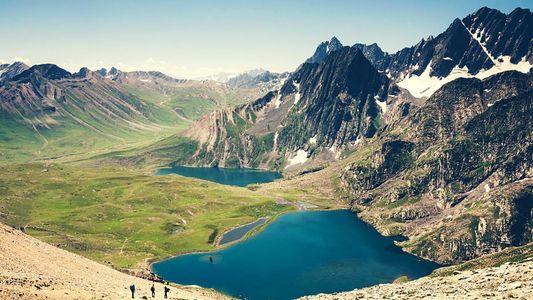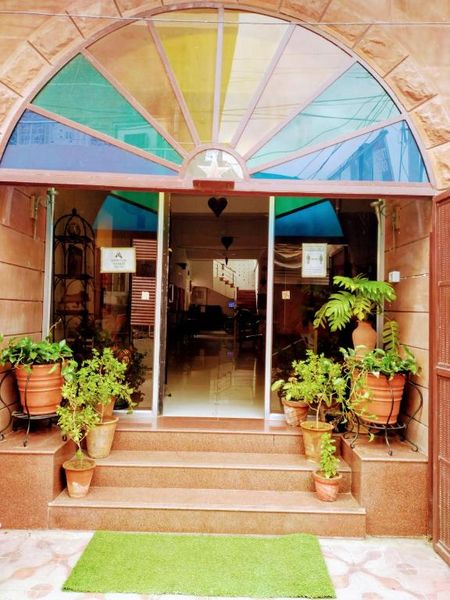Trek the Unforgettable: Discover the Beauty of the Kashmir Great Lakes
 Palakshi Meharwal
01 May, 2025
9 mins read
280
Palakshi Meharwal
01 May, 2025
9 mins read
280

Nestled deep within the pristine Himalayas, the Kashmir Great Lakes Trek offers an ethereal journey through some of the most breathtaking landscapes in India. As its name suggests, the trail showcases a collection of alpine lakes, each uniquely set against the dramatic backdrop of snow-capped peaks and lush meadows. For trekkers seeking a perfect blend of challenge, solitude, and scenic wonder, this trek is an unparalleled experience.
A Glimpse into Paradise
Often described as the “crown jewel†of Indian trekking, the Kashmir Great Lakes Trek spans roughly 70 to 75 kilometers over seven to nine days. The trail begins at Sonamarg, a hill station located about 80 km from Srinagar, and culminates in Naranag, offering a point-to-point trek rather than a loop. Throughout the journey, trekkers encounter a dazzling array of lakes—Vishansar, Krishansar, Gadsar, Satsar, and Gangbal, among others. Each lake has its own character, changing colors with the light, reflecting the rugged beauty of the mountains around them.
What sets this trek apart is not just its photogenic vistas but its emotional resonance. Walking through high-altitude meadows dotted with wildflowers, crossing glacier-fed streams, and sleeping under star-studded skies fosters a sense of peace and reverence rarely found in more commercial trekking routes.
Ideal Season and Weather Conditions
The Kashmir Great Lakes Trek is best undertaken between early July and late September, when the region is free of snow and nature is in full bloom. During this window, daytime temperatures remain mild (12–20°C), while nights can get chilly, dropping to around 3–5°C.
Early in the season, trekkers might still encounter snow patches, adding to the scenic appeal. By mid-August, the valleys explode in a riot of color, thanks to blooming alpine flowers—a favorite sight among nature photographers and botanists alike.
A Journey through Varied Terrains
One of the most enriching aspects of the trek is the ever-changing terrain. The journey begins with thick pine forests that slowly give way to open valleys and eventually to rugged high-altitude terrain. Steep ascents over mountain passes such as the Gadsar Pass (13,800 ft) offer panoramic views that leave even the most seasoned trekkers spellbound.
Water sources are plentiful, fed by glacial melt, and trekkers frequently walk beside streams that echo softly through the valleys. The trail requires moderate to good physical fitness, with daily hikes ranging between 10 to 15 kilometers. While the trek doesn’t involve technical climbing, the high altitude and continuous ascents and descents can be demanding.
Cultural Encounters and Local Life
Kashmir’s rich cultural heritage adds another layer to the trek. Along the way, you may come across Gujjar and Bakarwal shepherds, who seasonally migrate with their flocks. Their simple way of life, traditional attire, and warm hospitality provide valuable insights into a culture that thrives in harmony with the land.
Engaging with local guides or choosing a trekking company that employs locals not only enriches the experience but also contributes directly to the region’s economy, an important aspect of sustainable travel.
Safety and Permits
Given the trek’s proximity to the Line of Control (LoC), permits are mandatory, especially for foreign nationals. These are generally arranged by authorized trekking agencies, and it’s advisable to carry valid ID at all times. It’s also crucial to check the latest travel advisories, as political conditions in Kashmir can fluctuate.
Acclimatization and health precautions are vital. Though the trek does not go beyond 14,000 ft, symptoms of Acute Mountain Sickness (AMS) can appear. A gradual pace, proper hydration, and a day for acclimatization at higher camps are recommended.
Packing and Preparation
For a successful trek, preparation is key. A well-packed backpack should include:
- Layered clothing (thermal base layers, fleece jackets, waterproof outerwear)
- Good-quality trekking shoes
- Sunscreen and UV-protective sunglasses
- Personal medications and a basic first aid kit
- Reusable water bottles and water purification tablets
Travelers should aim for eco-conscious packing—minimize plastic use, carry waste bags, and avoid leaving any non-biodegradable litter behind. Kashmir’s fragile ecosystem requires responsible tourism to preserve its beauty for generations to come.
Booking Options and Guides
Several reputable operators offer organized treks, complete with guides, mule support, meals, and tents. It's recommended to go through licensed companies like Indiahikes, Trek The Himalayas, or Kashmir Treks, which maintain a strong emphasis on safety, environmental care, and community involvement.
Independent trekking is possible, but only for experienced hikers familiar with high-altitude navigation and local protocols. Opting for a guided experience ensures smoother logistics and deeper insights into the region’s history and geography.
Why This Trek Stands Out
While treks like Roopkund or Hampta Pass are stunning in their own right, the Kashmir Great Lakes Trek is in a league of its own. The sheer diversity of scenery—mirror-like lakes, jagged cliffs, gentle meadows, and ancient pine forests—makes it a photographer’s paradise and a hiker’s dream.
Beyond the physical beauty, the trail encourages a kind of emotional introspection, compelling one to slow down and absorb nature in its purest form. It's not just a trek; it’s an experience that resonates long after your boots are off.
Final Thoughts
Trekking the Kashmir Great Lakes is not merely about reaching a destination—it's about discovering a rhythm in nature, learning humility from towering peaks, and forging a deeper connection with the earth. For those seeking an unforgettable adventure infused with soul-stirring beauty and cultural richness, this trek delivers on every front.
Whether you’re a first-time hiker looking to challenge yourself or a seasoned trekker in search of a new high, the Kashmir Great Lakes Trek promises an unforgettable journey that’s well worth every step.
Written By:
Palakshi Meharwal



Hotels at your convenience
Now choose your stay according to your preference. From finding a place for your dream destination or a mere weekend getaway to business accommodations or brief stay, we have got you covered. Explore hotels as per your mood.


